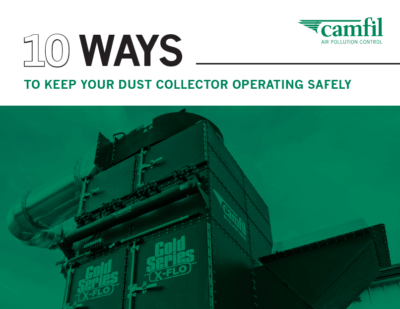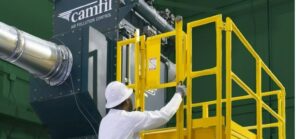We have added to our range of engineered solutions that help manufacturers improve safety and reduce operating expenses. It is always our top goal to provide healthier facility air, a cleaner work environment and a significantly reduced risk of combustible dust incidents.
The GOLDLink Plus™ monitoring system is a combined networking and sensor device that monitors any new or existing dust collector’s operation. It transmits real-time data to the cloud over a secure cellular modem. This system gives you valuable data to optimize dust collection and reduce overall downtime costs.
How Dust Collector Monitoring Works
The GOLDLink+ system checks critical points of the dust collection system via cloud-connected sensors that gather data around the clock. When the system detects a data reading out of the preset range, it sends notification to designated personnel for fast corrective action. This 24/7 filter performance monitoring can reveal unnoticed problems like high differential pressure, pulse cleaning system malfunction, dust hopper overload and the need to change out filters.
Standard sensors measure differential pressure to track pressure drop across the filters and temperature sensor to monitor the dust collector’s surrounding environment and conditions. Optional sensors include:
- Compressed air sensor to check for leaks of this expensive commodity
- Hopper & drum level sensor to detect dust build-up in these areas
- Particulate emissions sensor to detect filter leaks
- Airstream temperature & humidity sensor to detect fluctuations that can indicate malfunction
- Pulse count sensor to detect inconsistencies or faulty valves
- Airlock zero speed detection switch to detect plugged rotary valves
The logged data can also be used for trending, analysis and demonstrating compliance. IoT remote monitoring is especially useful for companies with many remote dust collectors, 24/7 operating schedules, sensitive applications or the need to generate reports for OSHA, the EPA or other regulatory bodies.
Integrating the Monitoring Device
The Camfil GOLDLink+ is a small box fitted with a 4-20mA differential pressure sensor and two pressure ports for ease of installation in any dust collector control panel. When activated, the device measures overall dust collector readings. The pressure data is transmitted to the cloud via a secure cellular modem where it is monitored by Camfil personnel at the Jonesboro, Arkansas, headquarters.
All data sent through the cellular network is fully encrypted end to end. This provides a fully isolated cloud connection without going through plant Ethernet networks. Camfil stores the data in its database, where sensor readings out of the normal range trigger an alarm notification. Camfil experts view the data and alert you to any issues that may require attention. Most often, high pressure readings signal that it is time to change out the filter cartridges.
In addition to receiving alerts, you can view the status of your system via Camfil’s dashboard from a phone, laptop, PC or tablet. If you have multiple dust collectors across various locations, you can view all data simultaneously for comparison purposes and analysis of performance trends.
Advantages of Dust Collector Monitoring
- Eliminate manual performance checks
- Reduce downtime
- Reduce filter changeout
- Proactive maintenance
- Reduce energy usage
- Automatically capture performance data required for regulatory compliance reports
- Monitor operator exposure risks
To learn more about the GOLDLink+ system, click here or contact a Camfil dust collection expert.
To learn more about designing a dust collection system that will keep your employees safe and your facility in compliance, contact the experts at Camfil APC.
 Americas
Americas 




